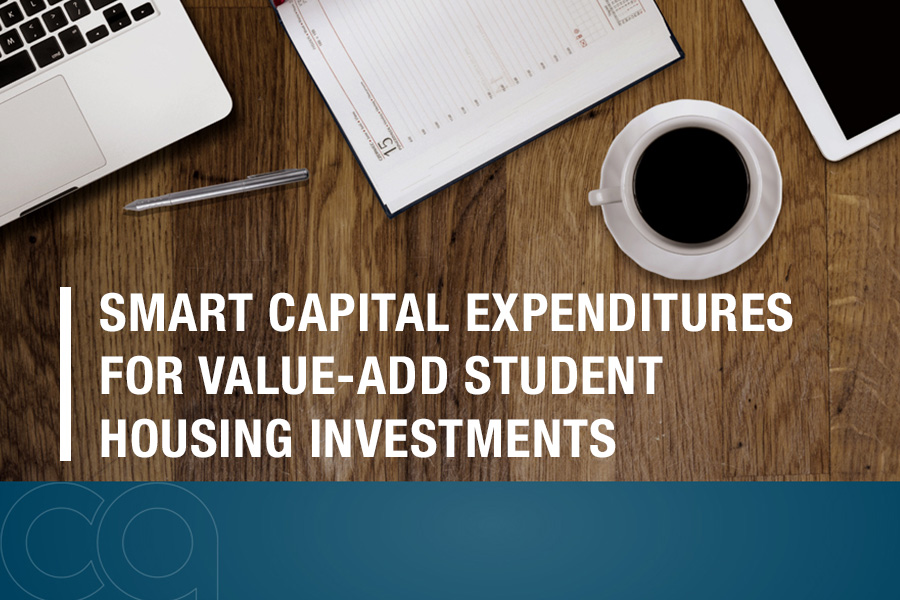Smart Capital Expenditures for Value-Add Student Housing Investments

Institutions and individual investors alike have recently turned to investing in student housing to diversify their portfolios, and many are seeking further diversification by investing in Core, Core Plus, Development, and Value-Add student properties, each with its own investment strategy. Value-Add investments typically offer the highest returns, but are coupled with the most risk. Establishing an underwriting strategy with achievable assumptions is key to delivering anticipated returns.
When determining where the most value exists in a potential investment, at Campus Advantage we focus on five main categories for improvement.
- Clubhouse and common area amenity improvements
- Unit interior improvements
- Exterior enhancements to boost curb appeal
- IT infrastructure changes to increase connectivity
- Operational improvements and reputation turnaround
The obvious course of action involves improving amenity spaces or upgrading unit interiors, but additional value can be derived from enhancing the curb appeal of the property, improving the connectivity offerings, or implementing a professional management platform that improves the day-to-day operations — and ultimately the property’s reputation. Heavy value-add investments typically involve four to five of these categories.
Before determining the amount of upfront capital to invest, the investor must assess their return potential. The crux of this step is assessing the depth of the market at higher price points to establish the ceiling for rental rate increases. Larger markets typically contain smaller sub-markets created by assets with similar locations, product types, and vintage, so first focus on the competitive set within the sub-market and identify one or two competitors to use as comparison for the asset repositioning strategy. Compare amenity offerings, reputation, and unit interiors, such as flooring, furniture packages, appliances, and countertops, to identify market standards, but also to uncover potential differentiating features like a new amenity concept or better furniture offerings that could set the property apart from its competitive set.
The market depth for higher priced units can be assessed by investigating:
- Student demographic data, specifically the socioeconomics of the parents and the percentage of students on Pell Grants or government aid. A high percentage of student loans granted based on financial need may point to rental rate limitations.
- Pre-leasing and occupancy trends at higher-priced competitors to offer an indication of whether the market gravitates to luxury properties or value properties, and when during the leasing cycle to capitalize on higher rents.
- Planned value-add strategies at recently acquired competitors to determine if additional rental rate increases will flood the market and drive students to the value properties.
- The student housing development pipeline to detect new luxury apartments that will charge a premium to warrant their development costs, and will result in the creation of a middle priced sub-market considered a value to the new supply.
The ultimate rent potential will yield the maximum upfront investment. If the analysis yields maximum rent increases are $50 per bed for a 500-bed property, then $3,000 per bed is the maximum investment to yield a 20% return. Some strategies also have the potential to change residual cap rate expectations, such as adding bathrooms to achieve bed/bath parity, which can also be factored into the ROI and net present value analysis.
Once the upfront investment amount is formalized, the investor needs to determine where to invest the capital. Unit upgrades are the most logical investment strategy because upgraded units can be sold at a premium to standard units and students can immediately identify the differences in unit qualities. Clubhouse and amenity renovations should be considered as these renovations typically realize additional rent growth through increased leasing velocity, when coupled with improved operations and marketing tactics. Management changes should also be weighed and factored into the strategy, as a strong operator is needed to execute after the transaction is complete.
A cohesive plan involving all accountable teams is critical to a value-add student housing investment, and determining the underwriting strategy is merely the first step. Campus Advantage has managed over $40M in strategic capital improvements as part of value-add investments, and our team has devised a four-step formula that ensures the operations team accomplishes the investment plan created during underwriting. Download our white paper, Four Step Formula for Executing a Value-Add Investment Strategy , to learn more.